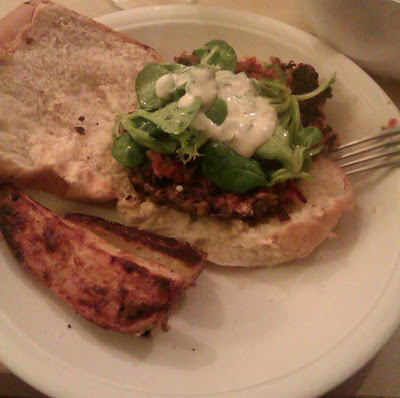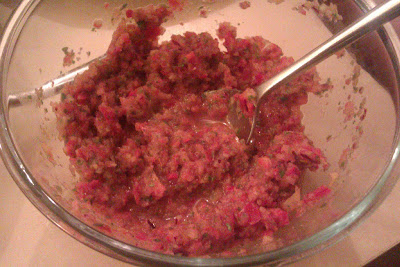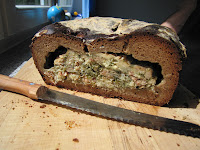 As with old
school British cooking, a handful of - from a modern viewpoint - truly scary
dishes (hello, haggis and steak and kidney pudding) are accompanied by several
others that, cooked well, remain delicious decade after decade. Such as
meatballs, for example. This recipe, adapted from Jane Lawson's brilliant
'Snowflakes and Schnapps', closely follows vintage Scandinavian recipes...with
a few unexpected twists and an accompaniment of drool-inducing slow-cooked red
cabbage.
As with old
school British cooking, a handful of - from a modern viewpoint - truly scary
dishes (hello, haggis and steak and kidney pudding) are accompanied by several
others that, cooked well, remain delicious decade after decade. Such as
meatballs, for example. This recipe, adapted from Jane Lawson's brilliant
'Snowflakes and Schnapps', closely follows vintage Scandinavian recipes...with
a few unexpected twists and an accompaniment of drool-inducing slow-cooked red
cabbage.
Ingredients:
enough for 2 immense portions, or 4 medium ones.
For the balls:
500g of
pork or beef mince - whichever you prefer
1 onion,
very finely chopped
1 clove of
garlic, very finely chopped
Breadcrumbs
- a good handful
Cream - a
few glugs
Allspice -
a generous pinch
Nutmeg - a
good grating of
Salt
Black
pepper
(optional:
dried and chopped forest mushrooms)
For the gravy:
A knob of
butter
Flour - 1
tablespoon
Chicken or
beef stock - half a pint or so, depending on how thick you want the gravy to be
Cream - to
taste
A glug of
vodka
A generous
bunch of dill, finely chopped
For the mash:
Potatoes
(surprise!) - peeled and quartered
A knob of
butter
A good glug
of milk
A generous
pinch of white pepper
Black
pepper
Salt
For the red cabbage:
Half a head
of red cabbage, roughly chopped
1 - 2
apples, roughly chopped
Oil and/or
butter
 1 onion,
finely chopped
1 onion,
finely chopped
1
tablespoon fennel seeds
A generous
glug of balsamic vinegar
How to
cook:
Firstly:
don't panic! I realise that's a massive list of ingredients, but all this is
easier than it looks. The cabbage and potatoes will take care of themselves
after initial preparation, and the gravy could barely be any easier if it
cooked itself.
Start with
the Balls. Mix all ingredients in a bowl and, hands freshly washed (hint: pour
a bit of oil on your mitts prior to sticking your hands in the dough to avoid
excessive stickiness), stir and squeeze for a good few minutes, until you have
a truly appetising mess of meat and other ingredients, all of it mixed well together.
After this, roll the mixture into evenly sized meatballs. Place the balls on a
baking tray and place in the fridge for at least an hour so the flavours have
time to develop.
In the
meantime, peel and quarter your potatoes and place in a large pan, ready for
boiling.
Move on to
the cabbage. Chop the red cabbage, onion and apple(s). Approximately 30 minutes
before your Balls are ready to go on the pan, place all three ingredients in a
roomy pan with a good glug of oil or a knob of butter (I prefer a combination
of both). Chuck in the fennel seeds, a pinch of salt and black pepper and a
good glug of balsamic vinegar, and leave to simmer on low heat for
approximately an hour, stirring regularly - if at appears too dry, pour in more
vinegar. The result is well worth the wait, I promise!
Just before
you're about to start cooking the Balls, put the potatoes on boil.
Heat a good
glug of oil, a knob of butter or a bit of both on a large frying pan. Once hot,
place the Balls in the pan. Be careful not to overcrowd them - you may need to
do this in two batches. Cook the Balls for about 10 minutes, depending on size
- the bigger they are, the longer you'll need. The aim is to get them nicely
browned on all sides.
Once this
is done, let the Balls rest in a bowl. In the meantime, place a knob of butter
on the pan you cooked the Balls in. Once the butter's melted, add the flour and
make sure you scrape in any leftover meatball scraps from the bottom of the
pan. Stir thoroughly, and gradually pour in your stock and cream. Keep
stirring. Add a glug of vodka (when in Finland, do as the Finns do...) and a
good handful of fresh, chopped dill, and bring to boil. Keep stirring until the
gravy has thickened a bit. Add the Balls that have been resting for a while,
and keep simmering on a soft boil for approximately 15 minutes, or until the
Balls are fully cooked and you have a nice, thick gravy.
By now,
your potatoes should have boiled. Drain them thoroughly in a colander and place
back in the pan. Add the spices, butter and milk, and mash until you have a
nice silky (as in 'unlumpy'!) texture. Put a lid on to keep them warm.
And that's
it, really - you're ready to plate up. I can guarantee that the outcome will be
worth the effort - these are strictly not factory-made Ikea meatballs! Enjoy.
.jpg)







.jpg)


